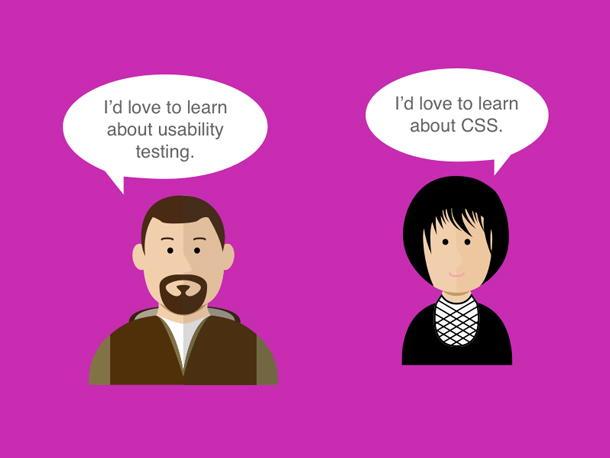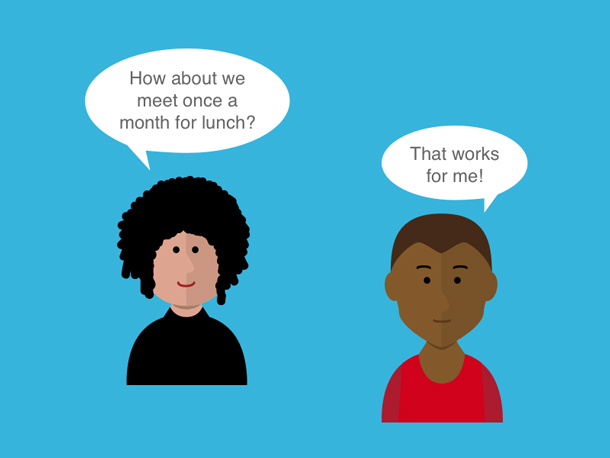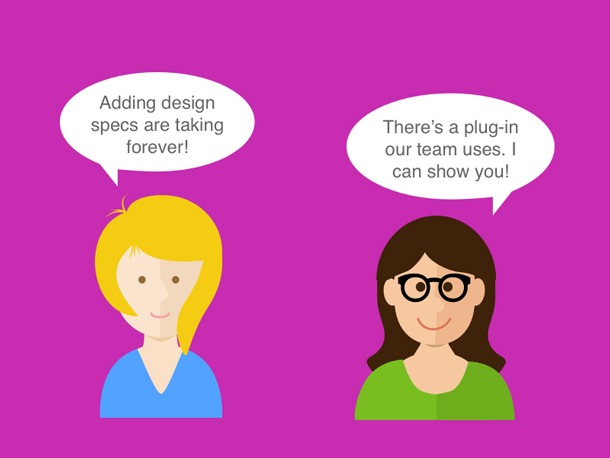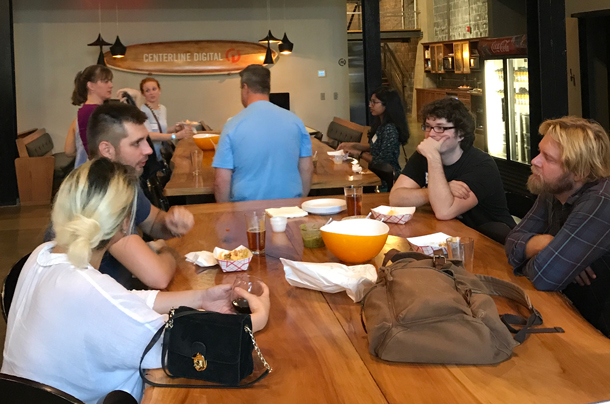Mentorship is one of the best ways to learn about a craft, advance skills, and achieve personal goals. It is especially important to the user experience (UX) field, where methods and best practices are constantly evolving and professionals must actively continue to learn. The field is also growing, and mentorship is a great way for new UX professionals to learn foundational concepts.
When thinking of mentorship, one may tend to think of a scenario where there is someone teaching and someone learning. However, both people in the relationship are actually learning. The proverb “by teaching we learn” is attributed to Western philosopher Seneca the Younger almost 2,000 years ago. Recent studies have proven this to be true. A study in 2007 suggested that first-born children are more intelligent because of the time they spend teaching their younger siblings. Other research shows that students who teach others scored higher on tests than students who only learned by themselves. This is known as The Protege Effect.
Learning is a key way to stay motivated. In a 2014 article, Donna Spencer wrote that if we don’t learn, we stagnate and become unhappy UX designers. Spencer a said, “Teaching will force you to examine your knowledge and become a better designer as a result.”
As volunteers in the Triangle UXPA (the North Carolina Raleigh/Durham/Chapel Hill chapter of UXPA), we wanted to help members of our chapter realize the importance of mentorship, too. We helped create and shape a mentorship program that has brought value to our community and to us personally. In this article, we will discuss how to get started as a mentee or mentor, and how to build a program of your own. We hope this article inspires you to try mentorship. Before we dive in, let’s go over what mentorship is and what forms it may take.
What is Mentorship?
Mentorship is a partnership between two or more people that’s focused on learning and development. A 2007 review and critique of mentoring theory described the three major benefits of mentorship as knowledge sharing, the transfer of social capital, and social support.
- Knowledge sharing involves a mentor teaching a mentee about their area of expertise.
- The transfer of social capital occurs when a mentee earns credibility by working with a mentor. A common example is when a mentor acts as a reference for a mentee when they’re applying for a job.
- Social support involves a mentor helping a mentee work through professional and personal situations with advice and emotional support.
Types of Mentorship
There are many types of mentorship, and you might find one more suitable for you than another. You might even be doing some form of mentorship already without realizing it.
Direct mentorship — This is traditional mentorship, where a junior-level person is being mentored by someone who’s more senior.
Peer mentorship — This is where both individuals are in similar roles and discuss their practices and share knowledge with one another (for example, two senior UX designers sharing knowledge with each other).
Mutual mentorship — This is also considered “cross-functional” mentorship—where two individuals teach each other different subjects. For instance, a UX designer shares knowledge about how to prioritize information in a hierarchy with a developer. In return, the developer shares a plan for responsive layouts.

Reverse mentorship — In reverse mentorship, a senior-level person is learning from a junior-level person. For example, a seasoned C-level executive learns from an entry-level coworker about Snapchat.
Indirect Mentorship — In this type of mentorship, the mentor is providing guidance to a group of people. For example, at the Triangle UXPA, we have a Slack account where mentors can provide advice to mentees.
Apprenticeship — We also wanted to define apprenticeship, so you can see how it differs from mentorship. An apprenticeship is a formalized training program, where an entry-level person becomes more experienced with the help of hands-on training.
With so many types of mentorship, there are more opportunities than you might think to seek or become a mentor.
Getting Started with Mentorship
Starting a mentorship relationship might seem intimidating, but it’s much easier than you think. While these are professional relationships, they don’t have to be so formalized and structured that it prevents you from participating. We actually encourage a more informal approach, which has worked well in our mentorship program.
Getting started as a mentee
As a mentee, much of the responsibility falls on you to initiate the relationship. Following these four steps can help you get started in the right direction.
Step 1. Identify your goals. Think about your goals and what you hope to accomplish through mentorship. Goals don’t always have to be aspirational such as, “transition to a UX career.” They can be smaller and focused. In the past, mentees sought mentorship from us to review portfolios. We’ve also had people who are a “UX team of one” meet with us just to share ideas with another UX designer.
Step 2. Find a mentor. Based on your goals, think about what type of mentorship you’re seeking. This can help guide you on where to find a mentor. For example, if you’re looking for a mutual mentorship, you might look for a mentor in another department at your work. If you’re looking for peer or direct mentorship, you might turn to your local UXPA chapter or a UX-related meetup. Professors and students at your local university can be another option, as well as your professional network. You can seek mentorship from a renowned UX author or pioneer, but we recommend looking for someone in your local community. Mentorship on a local level helps build a stronger community, and those mentors will likely be more accessible than someone who’s further away.
Step 3. Set expectations. Once you find a mentor, you both want to set expectations on how the relationship will work. Figure out how you will meet (for example, lunch, video chat, email, etc.) and how often you’ll meet (once a month, etc.). Also determine the length of the initial engagement (for example, three months). Most importantly, your mentor should understand your goals and be the ideal person who can help you accomplish them.

Step 4. Be Accountable Throughout the mentorship, be respectful of the effort your mentor is putting forth by being accountable. Be open to recommendations and ideas. Additionally, keep an open line of communication for anything small (for example, “I’m running late.”) to bigger concerns (for instance, you’re not sure the relationship is working out). Be professional. Even though we encourage a more informal approach, this is still a professional relationship. Always put your best foot forward. Most importantly, don’t use the mentorship for short-sighted gains! It’s not an opportunity for a job at that person’s company or access to their LinkedIn network. Mentors can sense that and sometimes it can hurt.
[bluebox]
A Mentorship Relationship Agreement
At the Triangle UXPA, we use a mentorship relationship agreement, which is a simple form that covers all the basic expectations. This allows both parties to be on the same page, which helps ensure the relationship starts off on the right foot. You can download a sample agreement here.
[/bluebox]
Getting started as a mentor
Becoming a mentor can be one of the most rewarding career experiences, and we encourage everyone to try it. However, there are some common myths that we sometimes use to convince ourselves otherwise. Let’s dispel these myths.
Myth 1: You don’t have enough experience. This myth goes hand-in-hand with imposter syndrome or the idea that you may reject your own accomplishments and feel like you’re a fraud. You may think you haven’t “made it” far enough to be a good mentor or to have something meaningful to teach. An example might be a designer with just a few years of experience who doesn’t feel comfortable mentoring another designer. Even though you probably do have enough experience to be a mentor, if you’re not comfortable engaging in a traditional mentorship, there are plenty of other options!
Here are some ways you can mentor others:
- Try out a different model, like mutual mentorship. Start up a conversation with a co-worker or someone at a meetup and talk about something new that’s happening in the field. This is a great way to ease into mentorship because it’s informal, yet intentional.
- If you’re not ready to share with a peer, you can try mentoring somebody outside of your discipline. Find a developer or an art director and teach them about usability testing or prototyping. You might find it easier to mentor someone with less familiarity on a topic. Don’t forget to ask them to teach you something, too!
- Finally, if you’re not up for engaging in mentorship directly with another person, you can try indirect mentorship. Write a blog post on your company’s site, for example.
Myth 2: You don’t have anything interesting to teach. One can interpret this myth as not having any skills to teach or thinking that everything you know is already common knowledge. You may get this feeling a lot when you’re reading articles and watching talks. It feels like it’s all been said before, so what could anyone have to add?
However, our discipline thrives when we share a diversity of perspectives; we value thinking about different ways of doing things. Exposing others to your techniques and ideas through the lens of your unique background helps us advance our discipline. Whether or not you think your experience is interesting, somebody else probably thinks it is. There’s something to learn from every project—good, bad, or ugly.
Here are some ways you can mentor others:
- Tell a story about your last project at your next team meeting. Explain what went really well or really wrong and ask the team if they’ve had similar experiences or how they might have handled things differently.
- Try explaining a new tool to a coworker. Maybe you’ve been using Sketch and your coworker, a longtime Photoshop designer, is looking to switch. Even though there are hundreds of tutorials online, you probably know some tips and tricks specific to your workplace that’s ten times more helpful than what’s online.
- Try responding on Twitter to the author of an article you just read. We tweet regularly about articles we read and sometimes an interesting conversation is sparked where everybody learns something new.

Keep in mind, we all have smart, interesting things to say, we just have to start saying them. You have a lot teach; you just have to begin teaching.
Myth 3: You don’t have enough time to be a mentor. We’re all busy, not just with our jobs, but with our lives outside of work and everything in between. It can be difficult to justify putting more time into the UX community when you’re giving it 100% at work. But through mentorship, you will find enriching and rewarding experiences. Mentorships are how lots of people get their first job; it’s how people learn new techniques, make new friends, and get inspired.
We’d go as far as to say that mentorship, when done right, isn’t an add-on to your life or career: it’s foundational to your life and career.
Here are some ways you can make time to be a mentor:
- Set boundaries for your mentorship. In the Triangle UXPA program, we ask mentors to specify the number of hours they’re willing to commit a month, so mentees align with the availability of each mentor.
- Mentor a co-worker at your office. Carving out some time at work might make it a little easier to jump into mentorship, even if it’s 30 minutes every other week or during lunch once a month.
- Get mentorship added to your work responsibilities. Check with your supervisor to see if this is possible. Then during quarterly and annual reviews, the great work you’ve put in as a mentor can be recognized.
Building a Program
In 2014, we created our UXPA chapter’s mentorship program to provide guidance to members interested in UX or just starting their career and looking to learn foundational concepts.
Over the past three years, our mentorship program has provided significant value to both individuals and our community. Mentorships from the program have not only educated mentees, but have also helped mentees land their first UX job. As our program evolved, mentees have become mentors and continue to pass on the knowledge they’ve gained, which has created a ripple effect throughout our UX community.
If you think a mentorship program could be of value in your community or organization, then we hope you consider building one, too! Creating something ambitious is a lot of fun, especially when you have the support of your friends or colleagues.
The Steps of Building a Program
The first step is determining who will help construct and facilitate the program. This could be one person or a small group of people who are directly responsible for determining the structure and launching it. For our chapter, we created a Mentorship Director position and their goal was to launch the program within a year.
Next, there are a few key considerations:
- Figure out how people are going to sign up. It could be as simple as a Google form embedded on your website. You just need a way to capture who’s interested in being a mentor or a mentee.
- Think about how mentors and mentees will be matched. Do they match themselves or does the program leader help match people? We use a self-service model in the Triangle UXPA program, where mentees can browse a directory of mentors. This means that mentees can find someone that they believe can more likely help them achieve their goals. Reaching out to a mentor might be too intimidating, so you might consider hosting “meet and greet” happy hours to help facilitate pairing.
- Consider how facilitators will follow up. Decide how you will follow up with mentors and mentees after they sign up and how you’ll get feedback on how to improve. For the Triangle UXPA, we email each mentor and mentee with directions and best practices after they sign up and we receive feedback via Slack and email.
- Figure out how your program will scale if it becomes successful. You want to avoid creating a program that can’t be expanded easily and efficiently. Figure out where you could have bottlenecks in the registration or matching process and take care of it while the program is still small.

Best Practices
Every mentorship program will be different and should address the needs of the community or organization it supports. However, there are some best practices that apply to any new program.
- Start small. Starting a program can take some effort, so keep the program small and manageable until a format evolves and the logistics are worked out. This will help increase the success of your program.
- Get support. Look to your local professional chapters of the UXPA, the IA Institute, IxDA, and others to build support for the program. They might be able to help promote the program, host mentorship events, and provide other opportunities to spark interest and facilitate mentoring matches. Leaders from other established UX mentorship programs might be able to offer insight.
- Don’t give up. Getting a mentorship program off the ground might be tough at first, but the value of trying to start one is worth the endeavor. You’ll meet some cool people along the way and you’ll be doing your part to help grow the field. Try different things, take note of what worked and what didn’t, and modify your approach with different solutions as needed.
Mentorship can have a big impact on individuals, workplaces, and communities. With so many different types available, there are many opportunities to try it, and it’s easy to start participating. We hope you’re feeling inspired to make mentorship part of your career!
